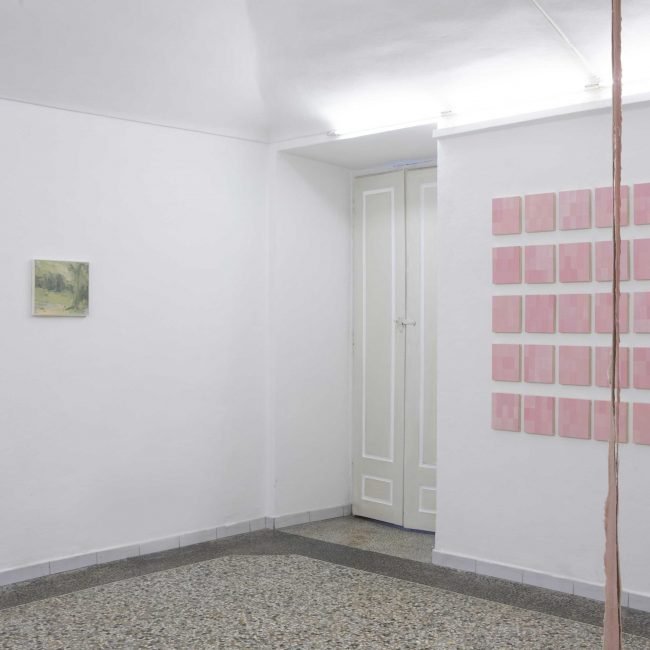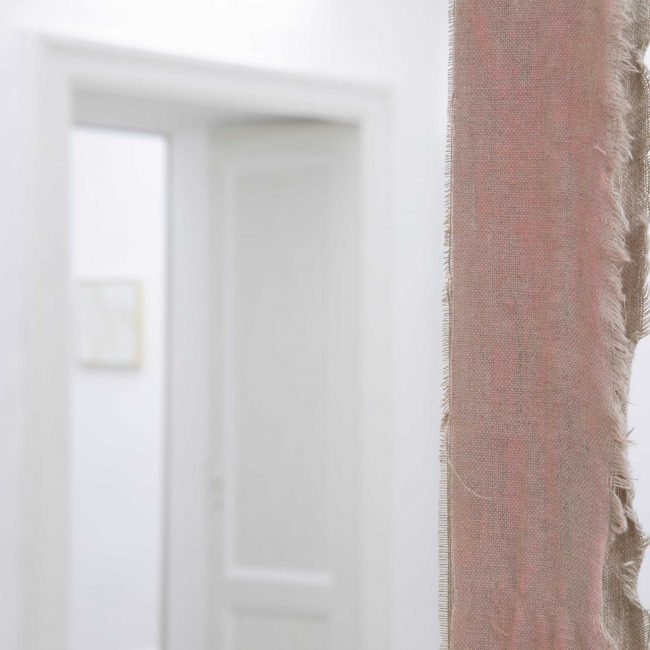SEBASTIANO IMPELLIZZERI
with a critical text by Samuele Piazza
27.10.2022 – 31.12.2022
Let placelessness be the place.
A journey, too, relies upon a frame.
In the spatial sense, the grid states the autonomy of the realm of art.
Flattened, geometricized, ordered, it is antinatural, antimimetic, antireal.
It is what art looks like when it turns its back on nature.
In the flatness that results from its coordinates, the grid is the means of crowding out the dimensions of the real and replacing them with the lateral spread of a single surface.
In the overall regularity of its organization, it is the result not of imitation, but of aesthetic decree.
Rosalind Krauss, Grids, OCTOBER, 1979
In a famous essay, Rosalind Krauss places the grid at the center of her reflection on pictorial modernism. This element is considered a constitutive feature of a new sensibility which, in the reading of criticism, brings the pictorial surface back to a new ground zero: freed from mimetic constraints and from any confrontation with the multiplicity of reality, painting becomes an organized meta-language within an order driven by purovisibilism.
In an ideological frame wanting modernist painters engaged in a continuous stripping of representation, the grid becomes emblem of the utmost abstraction; a space in which accidents are not allowed. Narrative is annihilated in favor of inaccessible aesthetic purity. The word is confined to silence.
The work welcoming the visitor into the exhibition is, at the same time, in continuity and in contrast with this history of modernism which sees in the grid an organizing principle: the polyptych occupating one of the gallery walls declares a gaze developed on American minimalist painting and on substantial painting, but simultaneosly questions with a touch of irony the self-referential objectivity of these movements.
The single pink “brushstrokes” filling the surfaces of the almost-monochromes are replaced by tissue papers of a shade particularly dear to the artist’s colour palette, which can be found in some packs of rolling papers as a warning that the content is about to finish. Collected for years, this humble pictorial material is painstakingly readjusted to create a new pictorial surface.
The resulting grid is embodied in an apparently abstract narrative but, the use of objects charged with rinterpersonal meaning, linked to time duration, to a lived experience, perhaps to certain specific moments, and certainly to a relationship with the body and with addiction, the boundaries of this grid fade, embedding it with a narrative role in which the variations in shade correspond to different times and registers, to be interpreted in a dynamic way, in sequences, as in a movie-like narrative.
The absolute nature of the modernist grid is dynamized to become something else: in an overcoming of Krauss’ idea of abstraction, the works on display are aimed towards what Travis Jeppeness would call “queer abstraction”: a rewriting, a language of the body where the body is not (re) present (ed).
When we speak of things queer, be they human or art objects or whatever, let’s speak of all those things whose inherent being is contingent upon a resistance to codification—whether that code be legal, signifying, or otherwise
Travis Jeppesen, Queer Abstraction (Or How to Be a Pervert with No Body). Some Notes Toward a Probability, Mousse Magazine, 2019
Grids have always been used to give order, to constitute universal, absolute models. Besides being a constant of modernist painting, they are also a fundamental element of cartography: the network of lines, paths and meridians that uniquely identify places, trying to impose a measurable and objective dimension on landscape.
Sebastiano Impellizzeri’s research is studded with maps that seem to struggle against a univocal, abstract, standardizing cartography imposed from bird’s eye view, from distance.
In his works the places are redesigned starting from firsthand experience, from memory or after passing through events. The grid falls apart to make room for an inscrutable and illegible map, which gives back an atmosphere, perhaps a spell, in opposition to a zenithal visualization of places, similar to the Google Maps panopticon. Desire lurks between the mesh of the grid and in the dynamics triggered by unveiling and resistance, vision and imagination, matter and memory.
The landscape immortalized in the video on display is a spot, once a place of fleeting encounters and battuage, today an abandoned corner of a park. The forest, in its tranquility, is reactivated through the headlights of a car that pierces darkness and humidity.
The siren song, recorded in a fortunate encounter in the middle of the sea, is amplified by the speakers of the car. The sound expands and penetrates every corner, reverberating on the surfaces and shaking them from their numbness. The energies once present in the now dormant place are reactivated by a call that seems to drive desiring bodies to itself and redesign a space with sound refractions. No human presence disturbs this unspoiled nature and the modulation of this pre-semantic song which, as Adorno and Horkeimer described in their “Dialectic of the Enlightenment”, seems to be the call of a repressed enjoyment asking to be freed to rejoin its prerational origin.
There is no narration, there is no word but the stubborn silence of the grid is broken to reach an abstraction different from the modernist tabula rasa; the space loses its physical connotations to become a potential image in which a new corporality can manifest itself.
Samuele Piazza is senior curator of OGR Torino where he curated and co-curated solo shows of different artists: Mike Nelson, Monica Bonvicini, Nina Canell, Maria Hassabi, Ramin and Rokni Haerizadeh and Hesam Rahmanian, besides the collective exhibitions “Vogliamo Tutto”, inspired by the eponymous novel by Nanni Balestrini and by the project “Dancing is what we make of falling”.
Before OGR he worked on individual projects, among which the exhibition “On Limits. Estrangement in the everyday at the Kitchen, NYC. 2015-16 Helena Rubinstein fellow del Whitney Museum ISP, he majored at the Center for Research in Modern European Philosophy, Kingston University, London with an MA in Aestetics and Art Theory and at IUAV University, Venice with an MA in Visual Arts.
















